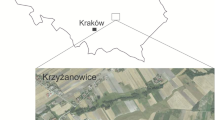Abstract
Traditional hay-meadows in the Alps and fens at the edge of the Alps are habitats for many rare and endangered butterfly species. Conservation efforts aim at preserving these species, but the biotopes depend on regular mowing, which in turn requires intensive financial support. The feasibility of substituting mowing of these sites by grazing is discussed and considered as a more cost effective management type which produces agriculturally valuable goods as well. In this study the butterfly fauna of mown and grazed sites were compared. Species composition, species number, and the occurrence of rare species under the two management types were in most cases rather similar for both grassland ecosystems. Nevertheless, there are hints that for single rare species this might not be true. Additionally, at one site, grazing intensity on a former hay-meadow was too high to preserve the species-rich community. Overall the results are encouraging: grazing does not have to be as detrimental as formerly thought, although details (compartments of pastures, intensity) still have to be confirmed. Experimental grazing management of aban-doned grasslands of the studied types should be started.
Similar content being viewed by others
References
Bakker, J.P. (1989) Nature management by grazing and cutting. On the ecological significance of grazing and cutting regimes applied to restore former species-rich grassland communities in the Netherlands. Dordrecht, Boston, London: Kluwer Academic Publishing.
Blab, J. (1993) Grundlagen des Biotopschutz für Tiere. 4. Auflage, Schriftenreihe für Landschaftspflege und Naturschutz, H. 24, 479 S. Bonn-Bad Godesberg: Bundesforschungsanstalt für Naturschutz und Landschaftsökologie.
Dolek, M. (1994) Der Einfluß der Schafbeweidung von Kalkmagerrasen in der Südlichen Frankenalb auf die Insektenfauna (Tagfalter, Heuschrecken). Veröff.reihe Agrarökologie, Vol. 10, 126 S. Bern: Haupt Verlag.
Dolek, M. (1995) Beweidung und Management von Kalkmagerrasen in der Frankenalb. Mitt. DGaaE 10(1–6), 327–31.
Douwes, P. (1976) An area census method for estimating butterfly population numbers. J. Res. Lep. 15(3), 146–52.
Erhardt, A. (1985) Diurnal Lepidoptera: sensitive indicators of cultivated and abandoned grassland. J. Appl. Ecol. 22, 849–61.
Erhardt, A. and Thomas, J.A. (1991) Lepidoptera as indicators of change in the seminatural grasslands of lowland and upland Europe. In The conservation of insects and their habitats (N.M. Collins and J.A. Thomas, eds) pp. 213–36. 15th Symposium of the Royal Entomological Society of London, 1989.
Geyer, A. and Bücker, M. (1992) Rote Liste gefährdeter Tagfalter (Rhopalocera) Bayerns. Schriftenr. Bayer. LfU 111, 206–13.
Geyer, A. and Dolek, M. (1995) Ükologie und Schutz des Apollofalters (Parnassius apollo) in der Frankenalb. Mitt. DGaaE 10(1–6), 333–6.
Gore, A.J.P. (1983) Mires: Swamp, bog, fen and moor. Ecosystems of the world Vol. 4A.
Harnischmacher, M. (1988) Möglichkeiten und Durchführung extensiver Nutzungs-und Pflegeformen auf Trockenhängen der Südlichen Frankenalb aus der Sicht des Naturschutzes. Schriftenr. Bayer. LfU 84, 115–23.
Lörtscher, M., Hänggi, A. and Antognoli, C. (1994) Zoological arguments for managing the abandoned grasslands on Monte San Giorgio based on data of three invertebrate groups (Lepidoptera, Araneae, Saltatoria). Mitt. Schweiz. Ent. Ges. 67, 421–35.
Luick, R. (1996) Extensive Rinderweiden. Gemeinsame Chancen für Natur, Landschaft und Landwirtschaft. Naturschutz und Landschaftsplanung 28(2), 37–45.
Meineke, J.-U. (1981) Zeitliche und räumliche Differenzierung von Lepidopteren in Moorkomplexen des Alpenvorlandes. Beih. Veröff. Naturschutz Landschaftspflege Bad.-Württ. 21, 133–44.
Pollard, E. (1977) A method for assessing changes in the abundance of butterflies. Biol. Conserv. 12, 115–34.
Pratt, R.M., Putman, R.J., Ekins, J.R. and Edwards, P.J. (1986) Use of habitat by free-ranging cattle and ponies in the New Forest, Southern England. J.Appl. Ecol. 23, 539–57.
Radlmair, S. and Laußmann, H. (in press) Auswirkungen extensiver Beweidung und Mahd von Moorstandorten in Süddentschland auf die Heuschreckenfauna (Saltatoria). Verhandl. Gfö.
Ringler, A. (1981) Die Alpenmoore Bayerns–Landschaftsökologische Grundlagen, Gefährdung, Schutzkonzept. Ber. ANL 5/1981: 4–98.
Ringler, A. (1995) Beweidung mit Rindern. In Lebensraumtyp Streuwiesen–Landschaftspflegekonzept Bayern Vol. II.9, (B. Quinger, U. Schwab, A. Ringler, M. Bräu, R. Strohwasser and J. Weber, eds) pp. 187–203. Bayer. Staatsministerium für Landesentwicklung und Umweltfragen and Bayer. Akademie für Naturschutz und Landschaftspflege.
Thomas, J.A. (1983) A quick method for estimating butterfly numbers during surveys. Biol. Conserv. 27, 195–211.
Thomas, J.A. (1991) Rare species conservation: Case studies of european butterflies. In The scientific management of temperate communities for conservation(I.F. Spellerberg, F.B. Goldsmith and M.G. Morris, eds) pp. 149–97. 31st symposium of the British Ecological Society, 1989.
Author information
Authors and Affiliations
Rights and permissions
About this article
Cite this article
Dolek , M., Geyer , A. Influence of management on butterflies of rare grassland ecosystems in Germany. Journal of Insect Conservation 1, 125–130 (1997). https://doi.org/10.1023/A:1018443412153
Issue Date:
DOI: https://doi.org/10.1023/A:1018443412153




